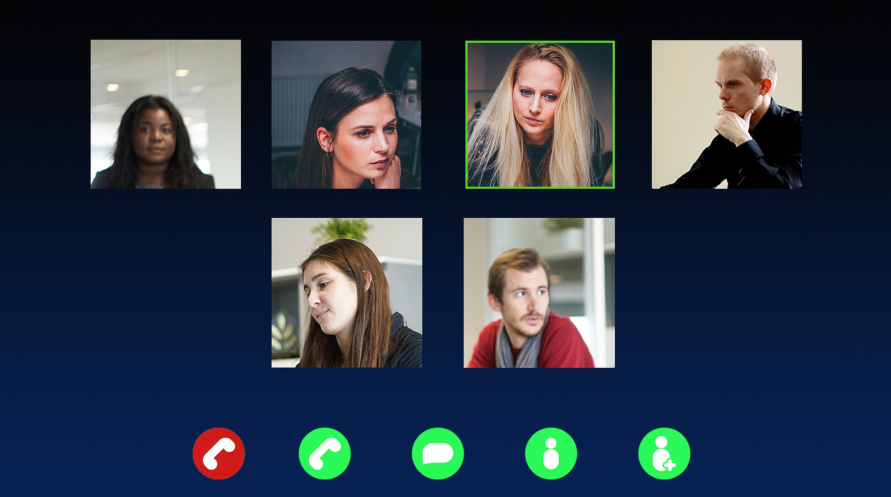With the advent of remote work, virtual all-hands meetings have become a ubiquitous aspect of company culture, offering a platform to share updates, strategies, and goals with the entire team. Despite the efficacy of these events in conveying information, they often need more engagement and interactive elements that have made in-person all-hands meetings in the past so impactful.
To tackle this challenge, organizations are elevating their virtual all-hands meetings with the integration of interactive elements such as live polls, Q&A sessions, and breakout rooms. These elements boost participation and engagement and cultivate a sense of community and connection among remote team members, who may otherwise feel isolated and disconnected.
With the proliferation of remote work, the need to uplevel your all-hands meetings has never been more pressing. By incorporating interactive elements, organizations can foster an engaging and immersive experience that strengthens their team’s sense of unity and purpose.
This article will explore the benefits of incorporating interactivity into your next company all-hands meeting. We will explore best practices for creating engaging and immersive virtual experiences that can foster a sense of community among remote team members and help to keep employees connected and engaged.
Benefits of Interactive Virtual Events
Interactive virtual events can provide numerous benefits for companies, including increased engagement, improved communication and collaboration, and increased productivity.

- Increased engagement: Integrating interactive elements such as live polls, Q&A sessions, breakout rooms, quizzes, and challenges, attendees can remain active and invested in the content, increasing the retention and implementation of critical information.
- Improved communication: This promotes a sense of community among remote workers and improves organizational communication.
- Better collaboration: Interactive virtual events allow employees to collectively work on projects, solve problems, and exchange ideas in real time, fostering a collaborative and cooperative work environment, even among those who work remotely.
- Increased productivity: Employees who feel connected to their colleagues and dedicated to the success of their organization are more likely to be motivated and productive. By designing your all-hands meetings to connect employees who don’t often work with each other, you’ll increase camaraderie and friendships within the company, and who knows, you might get an answer to a question that’s been stumping an entire function within the organization with a fresh perspective from someone over in HR or finance.
Best Practices for Interactive Virtual All-Hands Meetings
The visual aspect of virtual events holds immense significance in attracting and retaining the participants’ attention. A visual feast of high-quality graphics, images, videos, special effects, and animations creates an exciting and immersive experience.

Injecting a playful touch to virtual events is an effective way to elevate engagement and add an element of excitement. Gamification tactics, such as virtual scavenger hunts, trivia games, and many more, break the monotony and keep participants captivated.
Encouraging virtual networking sessions, chat rooms, and interactive activities can foster cooperation and a sense of belonging among remote team members while incorporating interactivity into virtual events can significantly enhance the overall experience for attendees.
Getting Your Employees To Know One Another
Getting your employees to know one another is crucial to building a solid and inclusive company culture. With more and more companies adopting remote work, fostering relationships among employees who don’t work in close proximity can be challenging.
That’s why it’s essential to make an effort to encourage your employees to get to know one another, even when they can’t be in the exact physical location.
Here are some of the key reasons why employees must know people outside of their immediate team:
Cross-silo collaboration: In the corporate world, bridging the gap between silos and fostering cross-functional collaboration can be a game-changer in organizational performance. By cultivating interdepartmental relationships, employees can develop a broader perspective, leading to more productive teamwork, innovative problem-solving, and a greater sense of unity throughout the company.

These strong interdepartmental bonds can serve as a catalyst for improved collaboration, setting the stage for more efficient, effective, and cohesive teamwork. When employees have the opportunity to forge connections with individuals from various teams and departments, they are empowered to unlock their full potential and drive organizational success.
Cultural + Interest groups: Championing diversity and inclusivity in the workplace can lead to numerous benefits, including improved collaboration, enhanced employee morale, and higher productivity. One way to achieve this is by fostering connections among employees from various departments and backgrounds.
By creating opportunities for employees to connect and engage with one another, you can establish a sense of community and belonging within your organization, fostering a more inclusive and diverse workplace culture.
Highlighting cultural groups and creating spaces for employees to share their unique experiences and perspectives can further strengthen this sense of community and promote understanding and appreciation for differences.
Also, there are likely people that share the same hobbies, be it outdoor activities, sports, gaming, books, anime, or fashion – for every hobby, there may be enough people to form a group at your company via which to connect via their personal communications channels when work is over. Celebrating these groups in the workplace gives people a sense of belonging.
Building a Strong Workforce through Inter-Collegial Relationships:
Companies can foster a sense of belonging and community by encouraging inter-collegial relationships among employees. When employees feel like they are part of a larger, connected group, they are more likely to view their job as a source of fulfillment and satisfaction rather than just a means to an end.

This can translate to lower rates of employee turnover, heightened job satisfaction, and elevated morale, all of which can contribute to a more productive and thriving workplace.
You can encourage your employees to get to know one another in several ways, even when they can’t be in the exact physical location. Here are some of the best practices for building relationships among remote employees:
Virtual Happy Hours
Skip an all-hands meeting once in a while and have a virtual happy hour instead. This tactic is best used as a surprise so they are planning to be at a work function anyway so they don’t skip it. Let’s be real, we know it happens. Be it a mid-week coffee break or a Friday night drink, offer a platform for employees to unwind and get to know one another. Chatting, catching up, and building relationships outside work have always been challenging. There ain’t no party like a skipped all-hands party because a skipped all-hands party is mandatory (that one is for all you 30 Rock/Tina Fey fans out there).
Interest Group Shout-outs
Encouraging employees to form interest groups based on hobbies or interests is an effective way to bring employees together. Whether they meet virtually or in person, these groups provide a unique opportunity for employees to connect, bond, and grow relationships even if they don’t work together directly.
Introducing the Workforce
During company-wide gatherings, allocate a few minutes to introduce employees to each other. This can be done through virtual introductions, ice-breaker activities, or having employees share personal insights. All-hands meetings can help employees feel more connected and engaged in the workplace by fostering relationships and creating a sense of community.
Team-building
Inviting employees to participate in group activities such as virtual trivia games, team-building exercises, or group challenges can be a fun and impactful way to encourage collaboration and relationship-building.

Fostering relationships among remote employees is crucial to building a solid and inclusive company culture. You can create a more connected and engaged virtual workplace by encouraging cross-silo collaboration, integrating cultural groups, making the workplace feel like a home, and fostering friendships.
Conclusion
Upleveling your company’s all-hands meetings with interactive virtual events can bring numerous benefits to your organization. Virtual events can transform your company’s operations through increased engagement, improved communication, collaboration, and productivity.
By implementing best practices like encouraging audience participation, making events visually appealing, adding gamification elements, and fostering networking opportunities, you can make sure your virtual events are engaging, productive, and effective.
Getting employees to know one another is crucial for improving team cohesion and fostering a sense of community within the company. Calling attention to cultural & interest groups and setting the stage for workplace friendships can create culture that feels like a family and not just a paycheck.
Reforming your all-hands gathering into an interactive virtual experience can be a huge boost to building a high-functioning and mega-productive work environment. Analyzing and applying feedback when planning these events can guarantee their success and relevance to the organization. With careful planning and a forward-thinking strategy, your virtual all-hands meeting can play a vital role in creating a more connected, harmonious, and profitable company.
Frequently Asked Questions
What are the benefits to thinking of your all-hands meetings as a virtual event?
Virtual events are planned, provide a degree of freedom for participants, cost-saving options for coordinators, and can amplify participation as distant attendees can participate with ease. Virtual all-hands meetings can escalate engagement and involvement by incorporating interactive elements and technology. Furthermore, virtual events create opportunities for attendees to network and interact with each other in a digital setting.
How can I encourage audience participation in virtual events?
Incorporating gamification, utilizing live polls, and fostering virtual networking opportunities are all highly effective methods. To increase engagement and participation, it is essential to make attendees feel valued and included.
How can I make virtual events visually appealing?
Incorporating consistent branding elements such as graphics, logos, and colors can create a uniform look and feel. A visually appealing virtual all-hands meeting has the potential to construct brand recognition and make a lasting impression on attendees.
What are some real-life examples of successful virtual events?
Examples include virtual editions of conferences such as South by Southwest, online product launches, and virtual trade shows. These events have successfully leveraged technology and creative approaches to engage attendees and achieve their goals.






